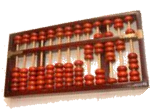| Interesting Math History |
|
|
| Question : |
|
What is an 'Abacus' ? |
Answer : |
|
The Abacus is a counting frame to aid in Arithmetic Computation - largely used in China and Japan. |
|
A simple form of Abacus
consists of a series of parallel wires or rods fastened in a wooden frame. There are counters or beads which are moved along
each rod. The position of each rod represents a certain place value.
|
|
An abacus is a calculating tool mostly used by Asians for performing arithmetic calculations. It is also called a counting
frame. They were originally made of beads or stones. The abacus was in use centuries before the adoption of the written
modern numeral system. |
 |
|
The word Abacus is derived from the Greek word Abax, means a
table or a board covered with dust. The origins of the Abacus
lies in the Middle East some where in early middle ages. |
|
Abacus was often constructed as a wooden frame with beads sliding on wires. |
|
The person who uses the abacus is called an abacist. It is used for addition and subtraction, and the related operations of
multiplication and division.
|